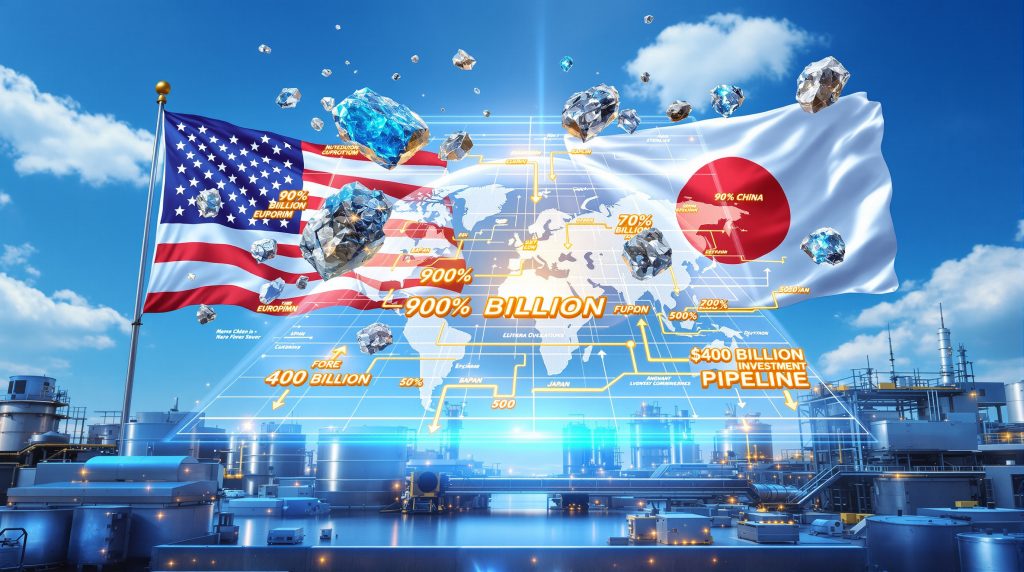Strategic Partnership Framework for Critical Mineral Security
The global economy's reliance on rare earth elements has created significant strategic vulnerabilities that nations are now scrambling to address through new bilateral frameworks. The US Japan rare earth minerals agreement represents a pivotal development in securing supply chains for these seventeen metallic elements, essential for everything from smartphone screens to military defense systems. This partnership addresses critical bottlenecks in modern supply chains while establishing protocols for enhanced critical minerals & energy security.
China currently dominates approximately 90% of global rare earth processing capacity, creating a concentration risk that has prompted urgent policy responses from Western nations. This dominance extends beyond raw extraction to include the complex refining and separation processes that transform raw ore into usable materials for high-tech applications.
The strategic importance of these materials cannot be overstated. Furthermore, a single F-35 fighter jet requires approximately 920 pounds of rare earth materials, while a typical electric vehicle battery contains multiple rare earth elements critical to performance and efficiency.
Why Are Nations Scrambling for Alternative Supply Sources?
Recent diplomatic developments have established new bilateral cooperation mechanisms designed to reduce critical mineral supply chain risks. According to US-Japan critical minerals partnership reports, framework agreements now encompass multiple dimensions of mineral security, from extraction partnerships to advanced recycling initiatives.
The cooperation structure includes several key components:
- Extraction technology sharing between mining sectors
- Processing capacity development in allied territories
- Recycling infrastructure investment to create circular supply loops
- Strategic stockpiling coordination for emergency reserves
- Investment mobilisation across public and private sectors
These partnerships represent a fundamental shift from single-source dependency toward diversified, resilient supply networks. The framework establishes protocols for information sharing, joint research initiatives, and coordinated responses to supply chain disruptions.
Financial Commitments and Investment Mobilisation
Industry analysts report significant capital commitments flowing toward rare earth supply chain diversification. However, the US Japan rare earth minerals agreement includes substantial private sector participation complementing government initiatives, building on comprehensive rare earth reserves analysis that identifies optimal development targets.
| Investment Category | Focus Areas | Timeline |
|---|---|---|
| Processing Infrastructure | Separation and refining facilities | 2025-2028 |
| Mining Operations | Domestic extraction capacity | 2025-2030 |
| Recycling Technology | Urban mining and recovery | 2026-2029 |
| Research & Development | Advanced processing methods | Ongoing |
The investment approach emphasises both immediate capacity building and long-term technological advancement. Consequently, private sector participation becomes crucial as government seed funding aims to leverage additional private capital for large-scale infrastructure development.
Which Industries Will Benefit Most From Supply Chain Transformation?
Defence and National Security Applications
Military technology relies heavily on rare earth elements for advanced guidance systems, radar technology, and precision-guided munitions. The defence sector has emerged as a primary driver behind supply chain diversification efforts, given the national security implications of foreign dependency.
Strategic stockpiling provisions within new agreements ensure military contractors maintain access to critical materials during potential supply disruptions. These reserves complement existing emergency stockpiles while establishing protocols for rapid deployment during crises.
Clean Energy and Automotive Revolution
The electric vehicle revolution depends entirely on secure rare earth supply chains. For instance, permanent magnets in EV motors require neodymium and dysprosium, while battery chemistries increasingly incorporate rare earth elements for enhanced performance and longevity.
Wind turbine generators present another critical application, with each large turbine requiring approximately 600 kilograms of rare earth materials for permanent magnet generators. The renewable energy transition cannot proceed without addressing these supply chain vulnerabilities, making initiatives like the battery recycling breakthrough increasingly valuable.
Manufacturing capacity expansion plans focus on creating domestic or allied-nation production capabilities for EV components. This includes not just final assembly but the entire supply chain from raw material processing through component manufacturing.
Electronics and Advanced Technology Sectors
Consumer electronics represent the largest volume application for rare earth elements, with smartphones, laptops, and tablets containing multiple rare earth components. The semiconductor industry's dependency creates particular vulnerabilities given the concentrated nature of chip manufacturing.
Innovation ecosystem support extends beyond immediate supply security to encompass research and development partnerships. These initiatives aim to develop alternative materials and more efficient processing technologies that could reduce overall rare earth consumption.
How Will Global Market Dynamics Change?
Price Stabilisation and Market Mechanisms
New supply chain frameworks aim to establish pricing mechanisms that reflect true extraction and processing costs while reducing extreme volatility. This approach potentially creates effective price floors for responsibly sourced materials, encouraging sustainable mining practices.
The pricing structure must balance several competing objectives:
- Incentivising new supply development through stable, profitable pricing
- Preventing excessive speculation that distorts industrial planning
- Reflecting environmental and social costs of responsible extraction
- Maintaining competitiveness with existing supply sources
Market Competition and Supply Diversification
Western-led supply chain alternatives face the challenge of competing with established, cost-optimised operations. However, supply security considerations increasingly outweigh pure cost optimisation in strategic industries, aligning with broader critical minerals pivot strategy initiatives.
Competitive pressure on existing suppliers may drive efficiency improvements and price moderation. Market share implications extend beyond immediate pricing to encompass technological leadership and long-term strategic positioning.
The emergence of alternative supply sources creates options for buyers previously dependent on single suppliers. This market fragmentation reduces individual supplier pricing power while potentially increasing overall industry investment in capacity expansion.
What Technology Partnerships Are Emerging?
Advanced Processing Technology Development
Joint research initiatives focus on improving extraction efficiency while reducing environmental impact. Processing technology advancement remains crucial as new supply sources may feature different ore characteristics requiring adapted separation techniques.
Environmental impact reduction methods include closed-loop processing systems that minimise waste generation and water consumption. These technologies become essential for gaining social licence to operate in environmentally sensitive regions.
Innovation partnerships extend to recycling technology development, with urban mining representing a potentially significant secondary supply source. Electronic waste contains concentrated rare earth elements that could supplement primary extraction through advanced recovery processes.
Collaborative Research Frameworks
Technology sharing protocols establish intellectual property frameworks that encourage innovation while protecting competitive advantages. These agreements balance open collaboration with commercial interests to accelerate technological development.
Expected outcomes include improved processing yields, reduced environmental impact, and lower overall production costs. Timeline expectations span multiple years as new technologies undergo development, testing, and commercial deployment phases.
Corporate Positioning and Regional Development Opportunities
Mining Sector Investment Landscape
According to mining industry evolution reports, copper prices recently reached fresh records, with London Metal Exchange prices climbing above $11,000 per ton. This price strength reflects broader commodity market dynamics that may influence rare earth investment decisions.
Regional development opportunities extend beyond direct mining operations to encompass supporting infrastructure, skilled workforce development, and technology services. Mining companies position themselves across the entire value chain rather than focusing solely on extraction.
Infrastructure Investment Requirements
Domestic capacity building initiatives require substantial infrastructure development, including:
- Transportation networks connecting mines to processing facilities
- Power supply infrastructure for energy-intensive separation processes
- Water treatment systems for environmental compliance
- Waste management facilities for processing byproducts
- Skilled workforce training programmes for specialised operations
The infrastructure investment timeline spans multiple years, with early-stage projects requiring significant capital commitments before generating returns. Government support mechanisms may include loan guarantees, tax incentives, and regulatory streamlining to accelerate development.
Geopolitical Implications and Market Restructuring
Reducing Concentrated Market Dependencies
Supply source redistribution targets aim to achieve meaningful diversification within defined timeframes. Current concentration levels present unacceptable risks that the US Japan rare earth minerals agreement specifically addresses through coordinated development efforts.
| Dependency Metric | Current Status | Target Level | Timeline |
|---|---|---|---|
| Single-Country Processing | >90% | <50% | 2030 |
| Alternative Supply Sources | Limited | Multiple | 2028 |
| Strategic Reserve Coverage | Months | Years | 2027 |
| Domestic Processing Capacity | Minimal | Substantial | 2030 |
Risk mitigation benchmarks provide measurable targets for supply chain resilience. These metrics enable policymakers to track progress toward diversification goals while identifying areas requiring additional attention or investment.
Allied Coordination and Multilateral Frameworks
Broader coalition building efforts extend beyond bilateral agreements to encompass multilateral cooperation frameworks. Moreover, similar agreements with multiple partners create redundant supply pathways while sharing development costs across allied nations.
Multilateral cooperation frameworks establish common standards for environmental practices, labour conditions, and quality specifications. These standards ensure that alternative supply sources meet requirements for high-tech applications while maintaining ethical sourcing practices.
Implementation Challenges and Risk Assessment
Technical and Infrastructure Hurdles
Processing capacity development faces significant technical challenges, particularly for complex rare earth separation processes. Skilled workforce requirements extend beyond traditional mining expertise to encompass advanced chemistry and materials science capabilities.
Environmental compliance standards continue evolving as regulators balance development urgency with environmental protection. These standards may require innovative approaches that exceed current industry practices, potentially increasing development costs and timelines.
Market and Economic Uncertainties
Commodity price volatility affects investment returns and project viability. According to recent mining sector coverage from Mining.com, metals markets remain subject to trade tensions, policy uncertainties, and demand fluctuations that complicate long-term planning.
Global demand fluctuation effects become particularly relevant as clean energy adoption rates vary across regions and economic cycles. Investment decisions must account for potential demand scenarios while maintaining financial viability under various market conditions.
Success Metrics and Future Strategic Benefits
Measurable Performance Indicators
Success measurement requires specific, quantifiable targets that stakeholders can track over time. Key performance indicators include:
- Percentage reduction in single-source dependency below critical thresholds
- Domestic processing capacity increases meeting predetermined targets
- Strategic reserve accumulation providing adequate emergency coverage
- Technology advancement milestones improving efficiency and sustainability
- Investment deployment rates meeting timeline expectations
- Environmental compliance achievements exceeding minimum standards
These metrics provide accountability mechanisms while enabling course corrections when progress falls short of expectations. Regular monitoring allows stakeholders to identify successful strategies and address implementation challenges proactively.
Long-term Strategic Advantages
Supply chain resilience improvements extend beyond immediate security concerns to encompass competitive advantages in emerging technologies. Nations with secure critical mineral access may lead in clean energy, advanced manufacturing, and defence technologies.
Economic security enhancements include reduced vulnerability to supply disruptions, price manipulation, and geopolitical tensions. Diversified supply chains provide options and leverage that single-source dependencies cannot offer.
In addition, innovation ecosystem development creates spillover benefits across multiple industries. Research partnerships, workforce development, and technology advancement initiatives strengthen broader industrial capabilities beyond immediate rare earth applications.
The US Japan rare earth minerals agreement therefore represents more than a bilateral trade arrangement—it signals a fundamental restructuring of global critical mineral supply chains toward greater resilience, security, and technological innovation. These strategic partnerships will likely shape the competitive landscape for critical technologies throughout the remainder of this decade.
Disclaimer: This analysis is based on publicly available information and industry reports. Market conditions, investment figures, and policy developments remain subject to change. Readers should consult current official sources for the most recent developments in critical mineral policy and market conditions.
Ready to Position Yourself in the Critical Minerals Investment Boom?
Discovery Alert's proprietary Discovery IQ model delivers real-time alerts on significant ASX mineral discoveries, instantly empowering subscribers to identify actionable opportunities in the expanding critical minerals sector ahead of the broader market. Begin your 30-day free trial today and secure your market-leading advantage as nations scramble to diversify their critical mineral supply chains.




